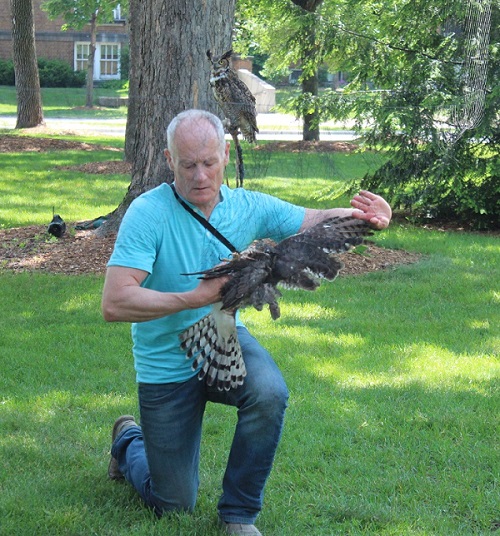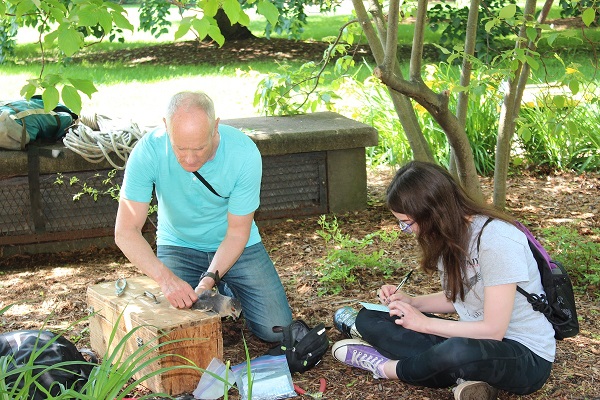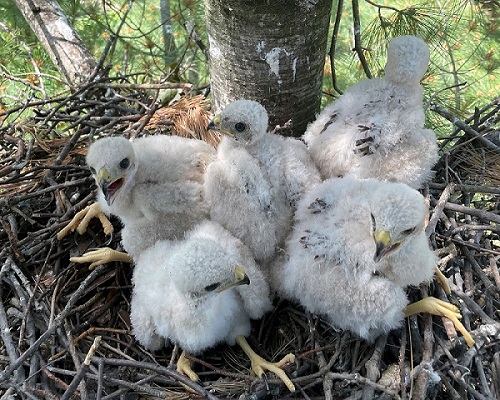From British Columbia to Mexico, from five states to several cities in Wisconsin, Biology Professor Bob Rosenfield has scaled trees for more than 40 years. It’s part of his ongoing research work on a bird of prey once believed near extinction, Cooper’s hawks.
This month, his research continued on the front lawn of Old Main at UW-Stevens Point. He discovered five eggs in a new nest. On June 14, when the five young hawks were big enough to retrieve and leg-band, Rosenfield put his research techniques on display.
Before he can access the chicks, the parent birds are trapped. To capture them, Rosenfield employs his UWSP-supported, live great horned owl. Blind in one eye following a vehicle accident in 2006, the owl was rehabilitated by the Raptor Education Group in Antigo.
 Biology Professor Bob Rosenfield nets a Cooper’s Hawk for study as his owl partner looks on.
Biology Professor Bob Rosenfield nets a Cooper’s Hawk for study as his owl partner looks on.Cooper’s hawks hate owls, so its presence draws them. The owl is tethered to a stand and cannot harm the hawks. But as a hawk swoops down, it is caught in a net Rosenfield has strung near the owl. He carefully untangles the male and places him in a metal tube to keep him safe while playing a recorded Cooper’s hawk alarm call to draw his female mate.
Rosenfield takes several measurements of both parents, including wing and tail length, weight, eye color and extent of molt. He bands them, a technique that helps him and other researchers track migration and longevity of the birds.
With the parents safely out of the way, Rosenfield straps on steel spurs and climbs about 35 feet up the white pine. He places the five chicks in a backpack and descends. They’re white, with a wingspan of nearly 12 inches already.
He distinguishes males from females by their size. Even as chicks, males are smaller. This size disparity continues into adulthood. Females are about one-third larger than males.
This is one of many facts he shares with his students of the day.
After completing his bachelor’s degree from UW-Stevens Point in 1980, Rosenfield was invited to track Cooper’s hawks, which were listed as a threatened species in Wisconsin. He worked closely with the late Ray Anderson, wildlife professor at UW-Stevens Point, to estimate the number of breeding Cooper’s hawks in the state.
 Biology Professor Bob Rosenfield works with wildlife ecology student Roxanne Gasperetti to take stats and band a male Cooper’s Hawk nesting near Old Main.
Biology Professor Bob Rosenfield works with wildlife ecology student Roxanne Gasperetti to take stats and band a male Cooper’s Hawk nesting near Old Main.Called chicken hawks by colonists because they plucked unprotected poultry from farms, Cooper’s hawks often were shot before the 1940s. Logging and development diminished the hawks’ forest habitat. Pesticide use in mid-20th century likely led to eggshell thinning, which further depleted populations.
Rosenfield initially looked for Cooper’s hawks in mixed forests or near rivers. Then he began to hear about hawks nesting in towns and cities, including Stevens Point and Milwaukee. This was not conventional raptor habitat.
He expanded his study and confirmed Cooper’s hawks were thriving in urban areas. They have adapted so well to urban environments that he describes the Cooper’s hawk today as “the most common backyard daytime breeding bird of prey in North America.”
Cooper’s hawks now have their highest densities and greatest reproductive successes in cities, he said. “Here in Wisconsin, however, I’ve discovered the city really doesn’t appear to be any better than a rural environment. So, Wisconsin overall is a good place for Cooper’s hawks.
“In my opinion, they are saturating their continental range. They occupy virtually every habitat that humans occupy,” said Rosenfield, considered the world’s foremost expert on the bird.
During his 43 years of research, Rosenfield has worked with seven breeding generations and scores of collaborators. Wisconsin Cooper’s hawks have advanced breeding about 1.3 days per decade in that time. The Wisconsin population has maintained the highest breeding densities, average clutch and brood/nestling counts for the species across their North American range, he said. This long-term data has been useful in Wisconsin and beyond.
 Five Cooper’s Hawk babies sit in their nest in a white pine on the front lawn of Old Main.
Five Cooper’s Hawk babies sit in their nest in a white pine on the front lawn of Old Main.Rosenfield collaborates globally with 105 scientists from every continent, a team led by Polish avian ecologists. Combined, they have collected enough data to track the global impact of climate change on various birds. They have discovered that unlike many other species of birds (including penguins, albatrosses and other seabirds, ducks, grouse, eagles and some songbirds), production of Cooper’s hawk offspring seems to have increased, or benefited, from climate change. This is based on research from 1970 – 2019.
More than 200 students have helped with his Cooper’s hawk studies, through field-oriented classes and research assistantships over the decades, Rosenfield said. Many of those have gone on to successful research careers, and some continue to be collaborators.
“I couldn’t possibly have gotten done what I have done without students and without the support of the administration at this campus.”
Rosenfield is currently focused on various nests around the state, including the Old Main chicks, working with citizens engaged in monitoring and learning about their backyard birds of prey. “I’m kind of like a farmer at this time of year, watching my crops grow.”